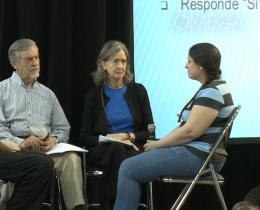Omega: You have engaged in long-term research to help shed light on why some marriages succeed and others don't. Aren’t relationships between individuals wholly unique and subject to environmental, chemical, and dynamic influences?
John: That's an empirical question. Is there a similarity between relationships that aren’t working well? And relationships that are functioning well, are they similar to one another? And are the two groups different from one another? The answer to all three questions is “yes.”
One of the main things that discriminates happy from unhappy couples is that in happy relationships people are able to repair negativity, whereas in unhappy relationships it’s very hard to get out of a negative state. In all kinds of relationships, people have conflict and disagreements and hurt one another’s feelings. What determines the success of the relationship is the way people deal with conflict, the nature of their friendship and intimacy, and their shared meaning system.
Julie: What you posed initially—if relationships differ by individual differences, environmental differences, and so on—most of that is myth. Most of that is stereotypes that our culture has perpetuated for a really long time. Research [at the Gottman Institute] debunks most of those myths. Regardless of these differences, we typically see exactly the same patterns that constitute dysfunctional relationships, and different patterns that constitute healthy relationships.
Omega: You speak at length about the importance of “fondness” and “admiration” in a relationship, and how without these elements a marriage becomes unworkable. How can a couple revitalize or discover such feelings?
Julie: Usually, either there is tremendous emotional distance that has shut down fondness and admiration, or there has been horrible conflict that shuts it down. What one has to do, in the conflict situation, is go back and process and repair regrettable incidents that have occurred between the partners so that they feel more deeply understood, so they feel the other partner has acknowledged responsibility, and they’ve talked about ways to avoid that kind of pain in the future. That begins to create enough safety and ease with vulnerability with one another that the fondness and admiration can come back again.
In order to express fondness and admiration, you have to feel safe enough with your partner to do so. When there’s a lot of emotional distance, when couples have just lived parallel lives, it’s really helpful to create rituals of connection—little bits of time they can count on spending together that is gentle time, good time, caring time, fun time, but time together—that helps them feel safe enough to resume that fondness and admiration.
There is the exception where, when couples have had a horrible time for many, many years, sometimes the fondness and admiration is gone for good and can’t be resurrected. We see that every now and then as well.
Omega: Many people insist that once the trust between two individuals has been compromised a relationship has little hope of finding an equitable and successful path forward. Do you agree?
Julie: Absolutely not. We disagree with it. Take affairs for example. We treat affairs quite a bit. In fact, we are engaged in the beginnings of a research study to look at how well our treatment works with affairs. What we can say is that we have a system through which we treat affairs and slowly rebuild trust. You can create marriage number two through processing the pain, through atonement—deep atonement—by the person who has betrayed the other. Then, you look at attunement, at really helping the partners to attune to one another in a very different way than they did initially. Finally, you create ways of renewing their attachment and their commitment to one another. That is the final stage of healing.
John: This approach comes out of doing research on how couples either build trust or erode trust and how they build either loyalty and commitment, or betrayal. When you see how couples go about the business of building trust in the relationship, then you have a pathway for understanding what the goals are in rebuilding trust and it doesn’t seem so magical and ethereal. It’s very practical. The suggestions for rebuilding trust really have recipes connected with them. It’s not this mysterious thing called therapy. There are really systematic ways of helping people get over the betrayal and rebuild "marriage number two," as Julie called it.
In dysfunctional relationships that erode trust, basically people just leave their partner in pain and move on, or dismiss their negative emotions by saying, “I don’t want to deal with your negativity.” When people build betrayal, they not only dismiss those negative emotions but they think to themselves, “I can do better. I don’t need this relationship. There’s a better one out there for me.” And that begins the slow process of not investing in the relationship, not sacrificing for the relationship, doing what Shirley Glass called “reversing walls and windows in the relationship,” and substituting for what’s missing instead of cherishing what you have.
We’re now testing whether we can help couples significantly rebuild trust. It’s still an empirical question.



